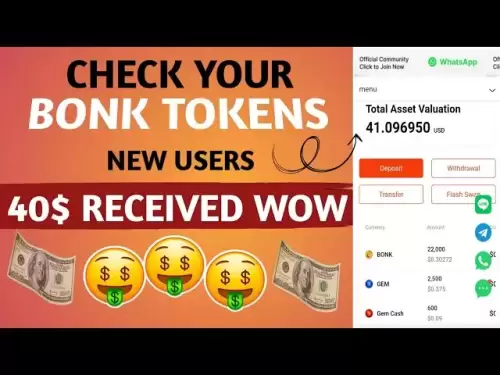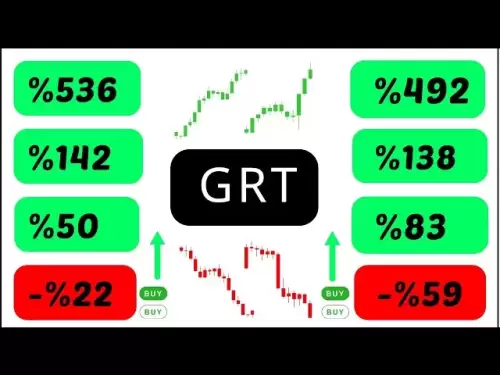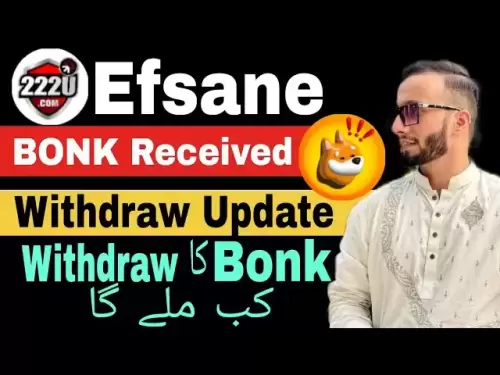-
 Bitcoin
Bitcoin $107,569.2021
1.41% -
 Ethereum
Ethereum $2,430.6950
-0.48% -
 Tether USDt
Tether USDt $1.0005
-0.01% -
 XRP
XRP $2.1884
-0.91% -
 BNB
BNB $647.4445
0.53% -
 Solana
Solana $144.2325
-0.49% -
 USDC
USDC $1.0000
-0.02% -
 TRON
TRON $0.2731
-0.48% -
 Dogecoin
Dogecoin $0.1658
0.61% -
 Cardano
Cardano $0.5694
-2.94% -
 Hyperliquid
Hyperliquid $37.2814
-0.09% -
 Bitcoin Cash
Bitcoin Cash $487.9461
7.41% -
 Sui
Sui $2.7788
-0.50% -
 Chainlink
Chainlink $13.2000
-1.28% -
 UNUS SED LEO
UNUS SED LEO $8.9994
0.22% -
 Stellar
Stellar $0.2417
-2.68% -
 Avalanche
Avalanche $17.6551
-2.73% -
 Toncoin
Toncoin $2.8498
-1.64% -
 Shiba Inu
Shiba Inu $0.0...01166
0.35% -
 Litecoin
Litecoin $84.6510
-0.54% -
 Hedera
Hedera $0.1507
-2.44% -
 Monero
Monero $315.5116
-0.39% -
 Ethena USDe
Ethena USDe $1.0001
-0.04% -
 Polkadot
Polkadot $3.3900
-1.91% -
 Dai
Dai $0.9999
0.00% -
 Bitget Token
Bitget Token $4.4262
3.03% -
 Pi
Pi $0.6122
12.98% -
 Uniswap
Uniswap $7.0039
-0.60% -
 Pepe
Pepe $0.0...09582
-3.75% -
 Aave
Aave $257.8121
-2.70%
What to do if BSV prices fluctuate greatly? How to use contracts to hedge risks?
To hedge against BSV price volatility, use futures, options, or swaps: futures lock in prices, options offer flexibility, and swaps exchange variable for fixed rates.
May 06, 2025 at 01:00 pm

When dealing with the volatile nature of Bitcoin SV (BSV) prices, it's crucial to understand how to manage and mitigate risks effectively. One of the most effective methods for managing these fluctuations is through the use of financial contracts, specifically hedging contracts. This article will explore the steps and strategies you can use to hedge against BSV price volatility using contracts.
Understanding BSV Price Fluctuations
BSV, like other cryptocurrencies, is known for its high volatility. Prices can swing dramatically within short periods due to various factors such as market sentiment, regulatory news, and technological developments. Understanding these fluctuations is the first step towards managing the associated risks. By keeping an eye on market trends and news, you can better predict potential price movements and prepare accordingly.
Types of Contracts for Hedging
There are several types of financial contracts that can be used to hedge against BSV price volatility. The most common include:
- Futures Contracts: These allow you to buy or sell BSV at a predetermined price on a future date, helping you lock in a price and mitigate the risk of adverse price movements.
- Options Contracts: These give you the right, but not the obligation, to buy or sell BSV at a specific price before a certain date. Options can be used to protect against downside risk while still allowing for potential upside gains.
- Swaps: These are agreements to exchange cash flows based on the price of BSV. Swaps can be used to hedge against price fluctuations by exchanging variable price risk for a fixed rate.
How to Use Futures Contracts for Hedging
Using futures contracts to hedge against BSV price fluctuations involves several steps:
- Choose a Reliable Exchange: Start by selecting a reputable cryptocurrency exchange that offers BSV futures trading. Ensure the exchange has a good track record and is compliant with regulatory standards.
- Open a Futures Account: You'll need to open a futures trading account on the chosen exchange. This usually involves providing personal information and completing a KYC (Know Your Customer) process.
- Analyze Market Conditions: Before entering into a futures contract, analyze the current market conditions for BSV. Look at price charts, market news, and technical indicators to predict future price movements.
- Select the Right Contract: Choose a futures contract that aligns with your hedging strategy. Consider the contract size, expiration date, and the price at which you want to lock in BSV.
- Enter the Contract: Once you've selected the appropriate contract, enter into it by placing an order on the exchange. You can either go long (buy) if you expect the price to rise or go short (sell) if you expect the price to fall.
- Monitor and Adjust: Keep an eye on the BSV market and adjust your position as necessary. If the market moves in your favor, you may choose to close the contract early to realize gains.
How to Use Options Contracts for Hedging
Options contracts offer a different approach to hedging BSV price volatility. Here's how to use them effectively:
- Select an Options Platform: Find a platform that offers BSV options trading. Ensure the platform is reputable and offers the types of options you need.
- Understand Options Basics: Familiarize yourself with the basics of options trading, including terms like call options, put options, strike price, and expiration date.
- Choose the Right Option: Decide whether you need a call option (to hedge against rising prices) or a put option (to hedge against falling prices). Select an option with a strike price and expiration date that suits your hedging strategy.
- Purchase the Option: Buy the chosen option on the platform. The cost of the option, known as the premium, will be your maximum potential loss.
- Monitor and Exercise: Keep track of BSV prices and the option's value. If the market moves in your favor, you can exercise the option to buy or sell BSV at the strike price. If not, you can let the option expire worthless, limiting your loss to the premium paid.
How to Use Swaps for Hedging
Swaps can be a powerful tool for hedging BSV price fluctuations. Here's how to use them:
- Find a Swap Counterparty: Identify a reliable counterparty willing to enter into a swap agreement with you. This could be another trader, a financial institution, or a specialized swap platform.
- Negotiate the Swap Terms: Agree on the terms of the swap, including the notional amount, the fixed rate, and the variable rate based on BSV prices. Ensure the terms align with your hedging needs.
- Enter the Swap Agreement: Once terms are agreed upon, enter into the swap agreement. This will involve exchanging cash flows based on the agreed-upon rates.
- Monitor and Manage: Regularly monitor BSV prices and the performance of the swap. Adjust the swap if necessary to maintain effective hedging.
Practical Example of Hedging with Contracts
To illustrate how these contracts work in practice, consider the following scenario:
Suppose you hold a significant amount of BSV and are concerned about a potential price drop. You decide to hedge using a put option.
- Step 1: You find a platform that offers BSV put options and select one with a strike price of $100 and an expiration date one month from now. The premium for this option is $5 per BSV.
- Step 2: You purchase the put option, paying a total premium of $500 for 100 BSV.
- Step 3: If BSV prices fall below $100 before the expiration date, you can exercise the option to sell your BSV at $100, limiting your loss. If BSV prices remain above $100, the option will expire worthless, and your loss will be limited to the $500 premium.
Frequently Asked Questions
Q: Can I use multiple types of contracts to hedge BSV price fluctuations?
A: Yes, you can use a combination of futures, options, and swaps to create a more robust hedging strategy. Each type of contract offers different benefits and can be tailored to your specific risk management needs.
Q: What are the costs associated with using contracts to hedge BSV?
A: The costs can vary depending on the type of contract. Futures contracts may involve margin requirements and transaction fees. Options contracts require paying a premium, while swaps may involve fees and the cost of entering into the agreement.
Q: How do I know which contract is best for my hedging strategy?
A: The best contract depends on your risk tolerance, market outlook, and financial goals. Futures are good for locking in prices, options offer flexibility with limited downside risk, and swaps can be used for more complex hedging strategies. Consider consulting with a financial advisor to determine the best approach for your situation.
Q: Are there any risks associated with using contracts to hedge BSV?
A: Yes, while hedging can mitigate risk, it's not without its own risks. Market movements can be unpredictable, and there's always the possibility that the hedge won't perform as expected. Additionally, there are costs associated with entering into and maintaining these contracts.
Disclaimer:info@kdj.com
The information provided is not trading advice. kdj.com does not assume any responsibility for any investments made based on the information provided in this article. Cryptocurrencies are highly volatile and it is highly recommended that you invest with caution after thorough research!
If you believe that the content used on this website infringes your copyright, please contact us immediately (info@kdj.com) and we will delete it promptly.
- Bitcoin, Dogecoin, Ethereum: Decoding the Crypto Buzz
- 2025-06-26 04:25:12
- Jupiter (JUP) Price: Downtrend in Danger? Trend Shift Watch!
- 2025-06-26 04:25:12
- Dogecoin Price Prediction: Crypto Analyst Eyes $1 Target – Is the Meme Coin Ready to Rally?
- 2025-06-26 04:45:12
- Coinbase, Shares, and Stablecoins: Riding the Crypto Wave
- 2025-06-26 04:30:12
- Tether, Bitcoin, and Crypto Funds: A New York Minute on the Latest Moves
- 2025-06-26 05:25:12
- Bitcoin Price: Is a Drop Incoming? Analyzing the Latest Predictions
- 2025-06-26 05:25:12
Related knowledge

How to customize USDT TRC20 mining fees? Flexible adjustment tutorial
Jun 13,2025 at 01:42am
Understanding USDT TRC20 Mining FeesMining fees on the TRON (TRC20) network are essential for processing transactions. Unlike Bitcoin or Ethereum, where miners directly validate transactions, TRON uses a delegated proof-of-stake (DPoS) mechanism. However, users still need to pay bandwidth and energy fees, which are collectively referred to as 'mining fe...

USDT TRC20 transaction is stuck? Solution summary
Jun 14,2025 at 11:15pm
Understanding USDT TRC20 TransactionsWhen users mention that a USDT TRC20 transaction is stuck, they typically refer to a situation where the transfer of Tether (USDT) on the TRON blockchain has not been confirmed for an extended period. This issue may arise due to various reasons such as network congestion, insufficient transaction fees, or wallet-rela...

How to cancel USDT TRC20 unconfirmed transactions? Operation guide
Jun 13,2025 at 11:01pm
Understanding USDT TRC20 Unconfirmed TransactionsWhen dealing with USDT TRC20 transactions, it’s crucial to understand what an unconfirmed transaction means. An unconfirmed transaction is one that has been broadcasted to the blockchain network but hasn’t yet been included in a block. This typically occurs due to low transaction fees or network congestio...

How to check USDT TRC20 balance? Introduction to multiple query methods
Jun 21,2025 at 02:42am
Understanding USDT TRC20 and Its ImportanceUSDT (Tether) is one of the most widely used stablecoins in the cryptocurrency market. It exists on multiple blockchain networks, including TRC20, which operates on the Tron (TRX) network. Checking your USDT TRC20 balance accurately is crucial for users who hold or transact with this asset. Whether you're sendi...

What to do if USDT TRC20 transfers are congested? Speed up trading skills
Jun 13,2025 at 09:56am
Understanding USDT TRC20 Transfer CongestionWhen transferring USDT TRC20, users may occasionally experience delays or congestion. This typically occurs due to network overload on the TRON blockchain, which hosts the TRC20 version of Tether. Unlike the ERC20 variant (which runs on Ethereum), TRC20 transactions are generally faster and cheaper, but during...

The relationship between USDT TRC20 and TRON chain: technical background analysis
Jun 12,2025 at 01:28pm
What is USDT TRC20?USDT TRC20 refers to the Tether (USDT) token issued on the TRON blockchain using the TRC-20 standard. Unlike the more commonly known ERC-20 version of USDT (which runs on Ethereum), the TRC-20 variant leverages the TRON network's infrastructure for faster and cheaper transactions. The emergence of this version came as part of Tether’s...

How to customize USDT TRC20 mining fees? Flexible adjustment tutorial
Jun 13,2025 at 01:42am
Understanding USDT TRC20 Mining FeesMining fees on the TRON (TRC20) network are essential for processing transactions. Unlike Bitcoin or Ethereum, where miners directly validate transactions, TRON uses a delegated proof-of-stake (DPoS) mechanism. However, users still need to pay bandwidth and energy fees, which are collectively referred to as 'mining fe...

USDT TRC20 transaction is stuck? Solution summary
Jun 14,2025 at 11:15pm
Understanding USDT TRC20 TransactionsWhen users mention that a USDT TRC20 transaction is stuck, they typically refer to a situation where the transfer of Tether (USDT) on the TRON blockchain has not been confirmed for an extended period. This issue may arise due to various reasons such as network congestion, insufficient transaction fees, or wallet-rela...

How to cancel USDT TRC20 unconfirmed transactions? Operation guide
Jun 13,2025 at 11:01pm
Understanding USDT TRC20 Unconfirmed TransactionsWhen dealing with USDT TRC20 transactions, it’s crucial to understand what an unconfirmed transaction means. An unconfirmed transaction is one that has been broadcasted to the blockchain network but hasn’t yet been included in a block. This typically occurs due to low transaction fees or network congestio...

How to check USDT TRC20 balance? Introduction to multiple query methods
Jun 21,2025 at 02:42am
Understanding USDT TRC20 and Its ImportanceUSDT (Tether) is one of the most widely used stablecoins in the cryptocurrency market. It exists on multiple blockchain networks, including TRC20, which operates on the Tron (TRX) network. Checking your USDT TRC20 balance accurately is crucial for users who hold or transact with this asset. Whether you're sendi...

What to do if USDT TRC20 transfers are congested? Speed up trading skills
Jun 13,2025 at 09:56am
Understanding USDT TRC20 Transfer CongestionWhen transferring USDT TRC20, users may occasionally experience delays or congestion. This typically occurs due to network overload on the TRON blockchain, which hosts the TRC20 version of Tether. Unlike the ERC20 variant (which runs on Ethereum), TRC20 transactions are generally faster and cheaper, but during...

The relationship between USDT TRC20 and TRON chain: technical background analysis
Jun 12,2025 at 01:28pm
What is USDT TRC20?USDT TRC20 refers to the Tether (USDT) token issued on the TRON blockchain using the TRC-20 standard. Unlike the more commonly known ERC-20 version of USDT (which runs on Ethereum), the TRC-20 variant leverages the TRON network's infrastructure for faster and cheaper transactions. The emergence of this version came as part of Tether’s...
See all articles
























































































